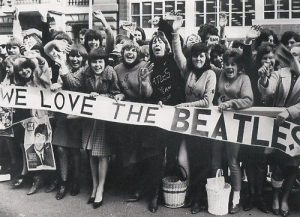The outpouring of affection for the Beatles surpassed that of Elvis, Johnny Ray, and Frank Sinatra throughout the first half of the twentieth century, and the group and their management were caught by surprise by their reception in the United States after having such extensive success in the  United Kingdom. Beatlemania, as it became known, symbolized a turning point in the lives of the youth following the band: “it was a magical time, a historic moment in the minds of an influential generation, and people who were there tell us that you had to experience it” (Millard 22). It became bigger than the Beatles in that it was one of the most successful large-scale merchandising campaign in American history as it was capitalized upon by entertainment industries via concert promotions, records, films, magazines, books, clothes, and toys in addition to inspiring countless copycat bands.
United Kingdom. Beatlemania, as it became known, symbolized a turning point in the lives of the youth following the band: “it was a magical time, a historic moment in the minds of an influential generation, and people who were there tell us that you had to experience it” (Millard 22). It became bigger than the Beatles in that it was one of the most successful large-scale merchandising campaign in American history as it was capitalized upon by entertainment industries via concert promotions, records, films, magazines, books, clothes, and toys in addition to inspiring countless copycat bands.
These seemingly obsessed fans, however, were not the seasoned rock fans one might expect, as the Beatles concerts were the first they had ever gone to. Girls wore their best clothes to the concerts and were often armed with things to throw at the group on stage.  Although Ringo Starr was fortunate enough to be hidden behind his drums, the rest of the group took the brunt of the objects thrown by fans. When it was revealed that George Harrison liked jelly beans, two tons per night were thrown at the group on stage “and it became the ‘obligatory throwing of jelly beans,’ a ritual invented by the fan that was repeated at every performance” (Millard 26)
Although Ringo Starr was fortunate enough to be hidden behind his drums, the rest of the group took the brunt of the objects thrown by fans. When it was revealed that George Harrison liked jelly beans, two tons per night were thrown at the group on stage “and it became the ‘obligatory throwing of jelly beans,’ a ritual invented by the fan that was repeated at every performance” (Millard 26)
Beatlemania swept into the United States as soon as their plane touched down on American soil on February 7, 1964. The group doubted that they would have success similar to that which they experienced in the UK while flying over the Atlantic but were met with thousands of screaming fans waiting for them at the airport (Andrews). The first few weeks of the Beatles in America were a whirlwind of appearances and performances at the Washington Coliseum, Carnegie Hall, and “The Ed Sullivan Show.” The number of American fans appearing at every location the Beatles were at while in the U.S. caused such a frenzy that “their management team had to distract fans with decoy Beatles wigs just to allow the group time to reach the stage” while performing in Washington D.C. (Andrews). Although the Beatles departed the US on February 22, the group transformed themselves into an oddity from overseas into absolutely stardom, placing five songs on the Billboard Hot 100 and breaking ratings records when their performances were televised. The “British Invasion,” as Walter Cronkite referred to it, had resulted in “conquest” (Andrews).